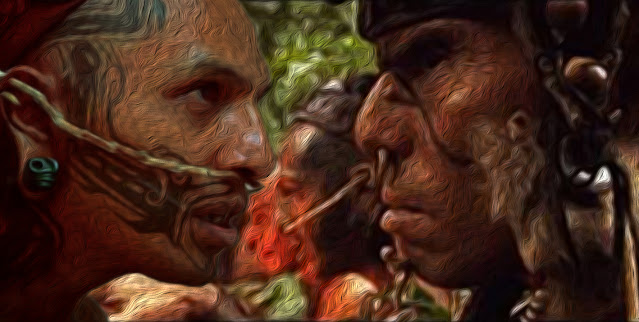"“The fault, dear Brutus, is not in our stars / But in ourselves, that we are underlings.” (W. Shakespeare, Julius Caesar, Act I, Scene III, L. 140–141)"
Can we design our way out of the climate catastrophe? We know the technical solutions. In Regeneration: Ending the Climate Crisis in One Generation, Paul Hawken puts the potential of the natural climate solutions (all forms of accelerated photosynthesis — tree-planting, soil recarbonization, ocean regeneration, etc.) at 1.6 trillion tons CO2e drawdown by 2050. That seems like a bunch but it is only approximately half of what will be needed to hold the line below 2 degrees of catastrophic warming, if that is even still possible. The other half would need to come from engineered solutions, assuming our man-made additions can be brought to zero.
Getting to zero by whatever date is a dicey proposition at the moment, as we watch mainstream media regard the filibuster of essential but insufficient climate legislation by 52 Senators as just normal political gamesmanship. It is considered standard, unremarkable, expected, that one political group or an individual politician would use whatever means available to obtain or hold office in a forthcoming election cycle and the particulars of what get destroyed along the way are of no significance — just collateral damage. Any visiting Venusian would see this for what it is — collective insanity. With a surface temperature hot enough to melt lead because of its greenhouse atmosphere, Venus should know.
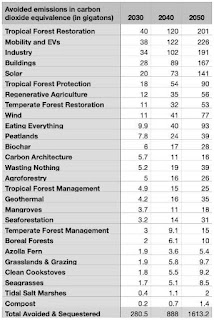 Kathleen Draper and I, in Burn: Igniting a New Carbon Drawdown Economy to End the Climate Crisis, pegged the potential for all-natural climate solutions at greater than 50 GtCO2e per year for the better part of a century. That comforting knowledge should temper the rush for fragile, expensive, energy-draining engineered inventions (artificial trees and orbiting sunscreens), remembering Sevareid’s Law (“the chief cause of problems is solutions”), but my point here is not to debate what kinds of solutions are best but that we know these solutions already exist. We have them. Done.
Kathleen Draper and I, in Burn: Igniting a New Carbon Drawdown Economy to End the Climate Crisis, pegged the potential for all-natural climate solutions at greater than 50 GtCO2e per year for the better part of a century. That comforting knowledge should temper the rush for fragile, expensive, energy-draining engineered inventions (artificial trees and orbiting sunscreens), remembering Sevareid’s Law (“the chief cause of problems is solutions”), but my point here is not to debate what kinds of solutions are best but that we know these solutions already exist. We have them. Done.
The problem lies not in our stars but in ourselves; not in our prowess but in our vulnerability. Genetic metaprograms that served us well through earlier evolutionary stages do us great disservice now and may augur our extinction unless unlearned or retrained. Hacking our genes directly is likely impossible, or at least highly improbable in the time remaining. Still, an epigenetic switch is not out of the question, and we know from history what can be done in a single generation with proper motivation.
The genes at issue are not specific to humans. Early in Cambrian speciation many creatures adopted herd strategy. Consider the wildebeest crossing a river full of crocodiles. Not all will reach the far shore, but most will. A lone individual would not stand a chance.
Many animals hunt in packs. They coordinate by sight, sound and other senses to surround and box in their prey. Our upright ancestors’ packs were so skilled they could skewer mastodons and whales on wooden spears with flint points. They would cluster around a central fire to protect their young. Later these would become towns, then cities.
When we go to a stadium today to root for the Red Sox or the Dodgers, or Packers, or All-Blacks, we signal to others in our tribe. We may not know their names, but we signal through what we wear, what we yell, when we leap to our feet and cheer. Sadly, the Olympics has become less about individual effort and more about national medal counts.
At the very least, the pandemic and climate catastrophe has brought disruptions of nature to our front doors, indeed to the spaces between us, our mutual respirations.
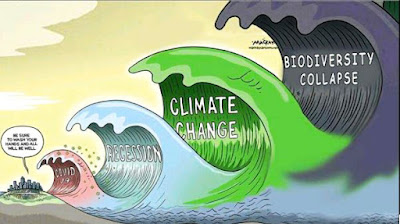 When as babies we were passed between relatives, when we grew up in a family home, or even in a foster institution, school, or on a street corner, we exchanged epigenetic data with everyone we came in contact with. Our growing cells internalized that information, as did the cells of those who donated to us. We “tribed” at a cellular level. Later separations, as they inevitably came in life, were only less traumatic by degree than separating Siamese twins.
When as babies we were passed between relatives, when we grew up in a family home, or even in a foster institution, school, or on a street corner, we exchanged epigenetic data with everyone we came in contact with. Our growing cells internalized that information, as did the cells of those who donated to us. We “tribed” at a cellular level. Later separations, as they inevitably came in life, were only less traumatic by degree than separating Siamese twins.
We learned to signal tribal allegiance as teens when we wore the latest in-group bling, Nike Air Jordans, or whatever. Maybe it was a tattoo or a piercing. The colors of a gang. Sometimes it was forced upon us. The badged blazer of boarding school. The khaki fatigues of boot camp. As we got older and tried to climb the social ladder, the signals we used might have been hairstyle, a pants-suit, a Harvard tie, a designer scarf. We signaled tribal intentions, whether we were members or just wannabes. We are scant different than fan-tailing peacocks or throat-puffing frigate birds.
Since Neolithic hunting packs first fought rivals over territory, those hard-wired proclivities were weaponized by tribal elders to breed for strong and fleet youth, train adolescent soldiers and pack them off to war, in platoons and companies loyal to flags, letters, numbers or totem animals — the Screaming Eagles, the Werewolves. Recent studies by Facebook and others confirm what psycho-anthropologists have long known: we are more easily angered by “them” than reinforced by “us.” We are easy prey to demagogues.
Our tribe bolsters us psychologically in myriad ways — ways used by advertisers often to profitable, although individually deleterious, effect. But it is the outrage emotion that really pushes us to sacrifice comfort, rest, and personal advantage for the sake of family, tribe, and nation. It is outrage that drives eyeballs to social media platforms and makes their monetized algorithms sing.
And we have a new study out where we found that the biggest single predictor of making something go viral is dunking on the out-group; saying something negative about the other side. And that’s 67% more likely to get shared. And so people learn this by getting reinforced and they realize this is the language that wins on social media.
— Jay Van Bavel, author of The Power of Us: Harnessing our shared identities to improve performance, increase cooperation and promote social harmony.
When Nelson Mandela went from prison to president, South Africa was deeply divided. Nobel Peace Prize or not, to many white South Africans, he was a criminal and a terrorist. Mandela flipped that by uniting his nation behind the Rugby World Cup. When the S.A. Springboks prevailed in overtime against New Zealand to take the prize, (white) team captain Francois Pienaar said, “I couldn’t sing the anthem because I knew I would cry. I was just so proud to be a South African that day.”
Shankar Vedantam, host of NPR’s Hidden Brain podcast, added a study guide to that story:
Across the country, black and white South Africans cheered together in triumph. Nelson Mandela knew that getting enemies to cheer for the same sports team was only a start. Much work remained to heal the wounds of apartheid. But his intervention revealed how a psychologically astute leader can find ways to create connections among people, even bitter enemies.
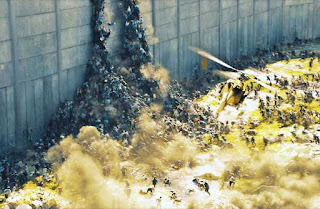 Jay Van Bavel, a psychologist at New York University, researches how our group loyalties affect our behaviors in all manner of situations. He told Vedantam:
Jay Van Bavel, a psychologist at New York University, researches how our group loyalties affect our behaviors in all manner of situations. He told Vedantam:
I ran studies like this, in Canada and the US, and many universities and online, and I’ve seen this same pattern over and over again. The moment that people are assigned to a team or a group, even though they often can know it’s a coin flip that’s determining this, means that they like those people more. They want to be friends with them. It shapes their automatic evaluations of those individuals. … what is referred to in the literature as “basking in reflected glory” is that when your in-group does well, it makes you feel good. You have a response in your brain as if you won or something good happened to you. And the same thing I think happens to sports fans. You can be sitting at home, watching the TV all alone and running around and jumping and cheering as if you’ve accomplished something when your team wins.
“Isms” are all ridiculous as far as I’m concerned.
— John Dennis Liu
Vedantam then bought up the dark side:
Groups offer us a sense of belonging, and they can bring out the best in us. But the flip side of most in-groups, there’s an out-group. … So, when I look out at the United States or other countries, I feel there are endless examples of how our group loyalties divide us. … So, many Americans increasingly believe that they don’t just disagree with people on the other side, but that people on the other side are inherently evil or untrustworthy.
The metaprogram shifts us from healthy disagreement into civil war. If you start to think people in the in-group are good and people in the out-group are evil (I confess to having shared this emotion) you may be tempted to do anything you can to stop the evil.
Walgreens recently shuttered four of its stores in San Francisco because shoplifting had become epidemic — several times per hour people were rushing the door to escape with stolen goods. A TV crew went to report on it and did not have to wait long to film shoplifters in the act — it was unexpectedly easy. Walgreens installed plexiglas and locks on shelves but that proved insufficient to stem their losses. The “us” versus “them” narrative took down their franchises.
Van Bavel says, “you’ll even support an in-group member or vote for a leader who you don’t like or don’t respect or don’t trust, simply because you can’t let this evil out-group take control. And so this is now a driving factor, behind many people in their decisions to vote, volunteer, donate money.” The latest surveys of Republicans show that 80% would like Donald Trump to run again in 2024. Forty percent would like for him to be unopposed in the primaries. Make America Great Again.
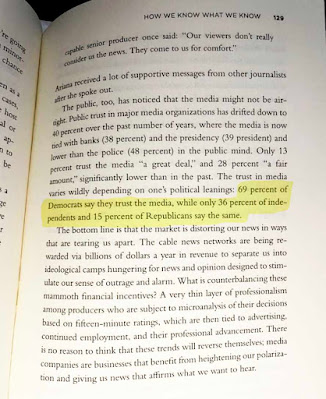 |
| Andrew Yang, Forward: Notes on the Future of Our Democracy |
Social media algorithms are designed to give little dopamine rewards by getting “likes” and “follows.” The more controversial your posts, the more likes and followers they draw. The object of the platform operators may be to drive ad revenues by glueing eyeballs, which doesn’t seem like a nefarious conspiracy, but the result is social corrosion, fake news, Brexit, Asian-hate, rigged elections in small countries, and demagogues who declare themselves Emperor for Life. Those algorithms are driving us toward climate, biodiversity, and nuclear Armageddon, and for what? To get likes.
Van Bavel says:
Research suggests that our Thanksgiving dinners are getting shorter by roughly half an hour over time. If you’re interacting with family members in a place where there’s going to be disagreement, politically, it becomes intolerable and people just don’t stick around for dessert…. [P]eople refuse to date somebody who voted for the other party. And so now there’s in fact, dating websites dedicated specifically to your political preferences.
… And what we’ve seen since January 2020 in the US, is that Republicans have seen the pandemic unfolding very differently than Democrats. And the leaders of the Republicans, this was Donald Trump, have downplayed it. And this affected people’s judgments of risk. It affected willingness to engage in spatial and social distancing. And we’ve studied that in my own lab and found that over time, the partisan gap between Democrats and Republicans in their willingness to engage in distancing actually increased as the pandemic spread. You might expect the opposite, which is that as people learn more about the risks, as people dying get in the hospital in your local state or city, you would actually follow the guidelines more. You wouldn’t be guided by partisanship. If anything, we found the exact opposite. And now you’re seeing that with vaccines. The big single biggest predictor of vaccine hesitancy continues to be identification with the Republican party. Thirty-two percent of Republicans don’t plan to get the vaccine while only 3 percent of Democrats don’t plan to. So that’s 10 times as many people are vaccine hesitant on that side of the political aisle.
The important thing to understand about social media is that nearly four billion people are on social media now and the average social media user scrolls through 300 feet of news feed a day. So it means if you have a six inch iPhone or Android, that means you’re scrolling down 600 times. It’s the height of the Statue of Liberty.
Climate deniers are reinforced with every swipe into thinking the problem is fake and action advocates are leading us to economic ruin. They get little dopamine hits with every like on a Looney-Tunes tweet. Climate action advocates are reinforced the same way. Their dopey tweets convince them that the deniers are stupid or misinformed. So they waste a lot of time doing scientific studies and webinars, blogging, making documentaries, and hosting concerts to “raise awareness,” none of which will ever be seen or heard by those they wish to influence, only by those who already agree with their point of view. In either case, people get their daily dose of outrage dopamine, affirm their tribal identity, and go to bed happy, or angry, or whatever floats their boat.
It doesn’t solve the problem.
What can solve the problem is using a strategy similar to what militaries do to recruit and inspire their innocent cannon fodder to heroic, lethal self-sacrifice. What if we recruited idealistic youth to an elite legion of superheroes, dedicated to saving the planet? The Climate Conservation Corps. Ecosystem Restoration Camps. Transition Network. Global Ecovillage Network. Permaculture Association. International Biochar Initiative, Trillion Tree Campaign. The enemy is not our fellow humans, who are at worst misinformed, not evil. The enemy is time. These ministries for the future can close that gap, planting mangroves, making biochar, harvesting kelp, rewatering peatlands, and permaculturing the desert.
That will give the human tribe something to tell its grandchildren some day.
The COVID-19 pandemic has destroyed lives, livelihoods, and economies. But it has not slowed down climate change, which presents an existential threat to all life, humans included. The warnings could not be stronger: temperatures and fires are breaking records, greenhouse gas levels keep climbing, sea level is rising, and natural disasters are upsizing.
As the world confronts the pandemic and emerges into recovery, there is growing recognition that the recovery must be a pathway to a new carbon economy, one that goes beyond zero emissions and runs the industrial carbon cycle backwards — taking CO2 from the atmosphere and ocean, turning it into coal and oil, and burying it in the ground. The triple bottom line of this new economy is antifragility, regeneration, and resilience.
Help me get my blog posted every week. All Patreon donations and Blogger subscriptions are needed and welcomed. You are how we make this happen. Your contributions are being made to Global Village Institute, a tax-deductible 501(c)(3) charity I have been involved with since its inception in 1974. PowerUp! donors on Patreon get an autographed book off each first press run. Please help if you can.
#RestorationGeneration
“There are the good tipping points, the tipping points in public consciousness when it comes to addressing this crisis, and I think we are very close to that.”
— Climate Scientist Michael Mann, January 13, 2021.
Want to help make a difference while you shop in the Amazon app, at no extra cost to you? Simply follow the instructions below to select “Global Village Institute” as your charity and activate AmazonSmile in the app. They’ll donate a portion of your eligible purchases to us.
How it works:
1. Open the Amazon app on your phone
2. Select the main menu (=) & tap on “AmazonSmile” within Programs & Features
3. Select “Global Village Institute” as your charity
4. Follow the on-screen instructions to activate AmazonSmile in the mobile app
